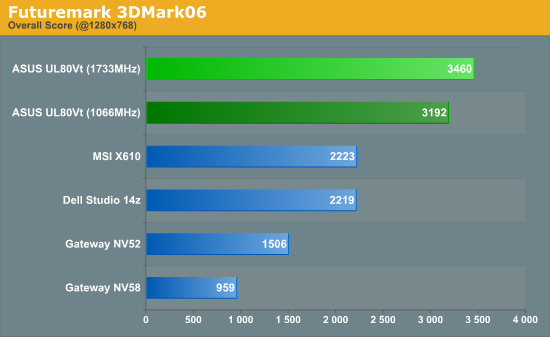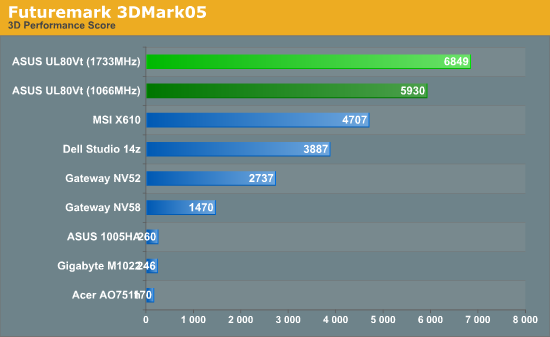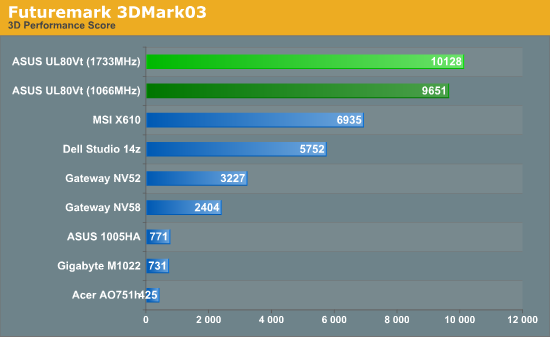ASUS UL80Vt First Look: Mobility Redefined
by Jarred Walton on October 24, 2009 8:00 PM EST- Posted in
- Laptops
ASUS UL80Vt Benchmarked - Graphics Performance
Our testing for now is confined to the use of the discrete GeForce G210M graphics on the UL80Vt. When we deliver our full review, we will include additional results using the integrated GMA 4500MHD. You can get a good idea of the 4500 MHD performance by looking at the Gateway NV58 results; the NV58 has a faster CPU, but for 3DMark and gaming performance the GPU is going to be a huge bottleneck.




Looking at 3DMark graphics performance, the G210M combined with the overclocked SU7300 delivers respectable performance. The G210M is clearly faster than the 9400M G integrated solution, with the advantage ranging from a low of 30% in 3DMark Vantage up to a high of 76% in 3DMark03. We realize 3DMark isn't true gaming performance, but most games correlate well with one of the versions. 3DMark06 and Vantage include CPU performance into the final score, which is why the gap between the 14z and UL80Vt isn't quite as large -- the P8600 should be at least 39% faster than the overclocked SU7300, and the detailed results confirm that. The CPU score in 3DMark06 is 1571 for the UL80 compared to 2117 with the 14z (a 35% advantage to the 14z), while the CPU score in Vantage is 3344 vs. 4284 for the 14z (28% faster). Meanwhile the 3D scores favor the UL80 by 58% in Vantage and 69% in 3DMark06. For reference, the Gateway NV52 with HD 3200 isn't even close in 3DMark; the UL80Vt is 130% to 214% faster!
Even at 1066MHz, the SU7300 with the G210M puts up a fight. The lead drops to 7.5% in Vantage (due primarily to the low CPU score), but it's still 44% in 06, 53% in 05, and 68% in 03. The comparison to the NV52 continues to be a landslide in favor of the SU7300+G210M: it's 105% faster in Vantage and up to 200% faster in 3DMark03.
We recognize that 3DMark isn't the be-all, end-all indicator of gaming performance, but as a quick test we can see that UL80Vt with the G210M enabled should never be slower than laptops with integrated graphics when it comes to gaming (i.e. the Dell 14z with 9400M G and the Gateway NV52 with HD 3200). It's also worth noting that the UL80Vt supports NVIDIA's reference drivers, just like other laptops with GeForce graphics (although you'll need to wait for updated drivers from NVIDIA if you want something newer than the 186.88 drivers the laptop ships with). At present, for graphics in notebooks the pecking order is roughly as follows:
- High-end and midrange discrete solutions (GeForce GTX 280M/260M and Mobility Radeon HD 4670 and 4870)
- Lower end discrete solution (Radeon HD 4330 and HD 3670, or GeForce 210M and 9600M, etc.)
- NVIDIA's current integrated graphics (GeForce 9400M G -- represented by the Dell Studio 14z).
- ATI's current integrated graphics (Radeon HD 3200 -- i.e. the Gateway NV52).
- Intel GMA 4500MHD and older NVIDIA/ATI IGP solutions (X1260 or GeForce 7000 or earlier).
- Intel's GMA 950 and earlier (typically seen in netbooks now).
The corollary to the above is pricing and power, and generally speaking the higher you go on the list, the more expensive the parts become and the worse battery life you get. That's the great benefit of designs like the UL80Vt: you can get reasonable graphics performance when you need/want it, but you can still switch off the graphics and run on the IGP for improved battery life. The G210M is designed to use a maximum of 8W, but when the rest of the laptop averages less than 10W of power, that's a potential 80% increase in power requirements. The slower IGP solutions -- especially from Intel -- do manage to keep power requirements low while offering dismal gaming performance. The HD 3200 and 9400M are much more palatable in terms of overall performance and video offloading features, with power requirements that are about the same as the GMA 4500.










100 Comments
View All Comments
feelingshorter - Sunday, October 25, 2009 - link
We understand that it takes a long time to test the battery. Just wanted to know that you are working on it for the final review. Thanks :)CurseTheSky - Sunday, October 25, 2009 - link
I just bought a UL30A-A2 on Thursday. It's a wonderful laptop, though not quite perfect.Unlike the ULxxVt laptops, the non-Vts come with just the X4500MHD, which is abysmal for anything other than general web browsing and watching movies. While I love the smallness of my 13.3", if I had read sooner than the UL80Vt comes with on-the-fly switchable graphics, I probably would have bought it instead. Oh well. Additionally, as far as I know the entire UL series also lacks Bluetooth, which kind of sucks. ASUS stated somewhere (one Amazon, I believe) that they're considering bundling a USB Bluetooth dongle.
Anyway, what was said in this article about the build quality is very true. It's sort of a mixed bag, but overall much better than most of the competition. The brushed aluminum cover is a very nice touch, and the plastic palm rest doesn't feel all that bad. The glossy black around the LCD is annoying (adds extra glare and really attracts finger prints), but the hinges really feel solid and the keyboard is excellent. The trackpad is a bit odd, but I find that I actually like it. Don't expect a Macbook Pro / Air in terms of fit and finish, but do expect something that'll get your friends or the locals at Starbucks asking "What's an ASUS?" and "That's nice, where did you get that?" Best of all, it doesn't cost as much as a Macbook Pro.
Really, the best part of these things is the battery life. Several reviews I've read have clocked around 8-9 hours real-world performance (ASUS claims 16 on my particular model, and the consensus seems to be that 12-13 wouldn't be unreasonable in a best-case scenario). I can't wait to read the Anandtech follow-up; I've always loved their testing methodology. The thinness and lightness of the series - particularly the smaller models - is also a huge plus.
Overall, great article, and great laptop. For anyone that values portability over performance but still wants something that'll fair (much) better than a netbook under stress, I highly recommend the UL series. Nice job ASUS.
Gooberlx2 - Monday, October 26, 2009 - link
http://www.amazon.com/UL30vt/forum/Fx1978M98LGJ2GT...">http://www.amazon.com/UL30vt/forum/Fx19...mp;store...Maybe the UL30vt will be available stateside some time in December?
I don't really put too much stock in to forum postings from sources one can't really verify. But since I won't have any $$$ until at least after the New Year, I'm certainly hoping it's true.
Uncreative - Sunday, October 25, 2009 - link
I've been watching this one ever since you guys posted the first look on the UL50VT. I've been looking to buy a laptop for class and a one day charge to last me through lecture and a good couple hours at the library would be perfect. I'm definately with you on the panel, I'd gladly pay more for a better LCD.I saw that they had the SU9400 listed as one of the possible models, was wondering if anyone has any idea when/if that model is coming?
Drizzt321 - Sunday, October 25, 2009 - link
Wow, I've have been wanting to find a laptop with one of the ULV Intel processors that doesn't cost an arm and a leg. Add to that the switchable graphics, and decent cost, and I think I've found my winner! Except, of course, the LCD. I'd like to do some graphics work (digital photography) on the go, and a good quality panel would be very nice. Hell, just give me a nice TN panel with this laptop and I'll be good. Give me an IPS/MVA/PVA panel and I'll be in heaven. For one of those good panels, I'd happily pay an extra $150-$200. Do you hear that Asus? There are people willing to pay for quality!dtham - Monday, October 26, 2009 - link
This is very ideal for schoolwork etc. I would love to see one that has a touchscreen display for taking notes, etc.The downside to the touchscreen is that it will be likely to have an even worse screen. However, with battery life for light work like this it would be absolutely awesome for students.
JarredWalton - Monday, October 26, 2009 - link
Ugh... I hate touch screens. I can type at 60 WPM, or chicken scratch at about 20 WPM (okay, maybe 30?) Anyway, you can get the Acer Aspire 5738PM with a touch screen, but that has worse battery life and it's not a tablet. I wouldn't buy a touch screen, though, unless things were much better than the last time I used one.chrnochime - Sunday, October 25, 2009 - link
At a higher price of 1.5k, manufacturers KNOW they can better justify adding that option, since people paying that much for laptop are much more willing to pay a bit more for PVA than those at the 820 USD price.Consider this: 200 for a panel option on a laptop that costs 820. That's almost 25% increase. Versus 200 on a 1500, which is ~13.4%. Latter case much more acceptable to buyer when taking original price into account.
munim - Sunday, October 25, 2009 - link
Dude: Hey is that a Macbook Air?Dudette: No, it's an ASUS UL80Vt
Dude: You'll what?
san1s - Saturday, October 24, 2009 - link
this looks great, and it has an optical drive. I wonder if there's any way to get it past 1.7 ghz?